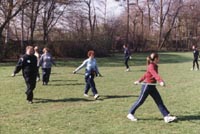Walking is not exercise enough to stay fit
It’s one of the most popular forms of exercise, but walking isn't as good for you as many people think, according to researchers from the University of Alberta in Canada.

“Generally, low-intensity activity such as walking alone is not likely going to give anybody marked health benefits compared to programs that occasionally elevate the intensity,” said Vicki Harber, lead author of a study presented recently at the American College of Sports Medicine annual conference, reports Cosmos.
According to BBC News, Dr Harber and her colleagues were concerned there was too much focus on simply getting people to take exercise, rather than on its intensity.
They compared people on a 10,000-step exercise regime, which they completed at their own pace, with a group whose routine was tougher, but which left them enough breath to be able to speak one or two sentences with ease at the end.
Both routines, which lasted for six months, burned off the same amount of energy. In total 128 sedentary people took part in the project.
The researchers assessed impact on fitness by measuring blood pressure, and peak oxygen uptake, a measure of lung capacity.
They found that the step programme increased peak oxygen uptake by an average of 4% over the six months - but the figure for the moderate intensity exercise group was 10%.
Other markers of overall health, such as fasting plasma glucose levels and blood fat levels were unaffected by either exercise programme.
The step walker's blood pressure lowered by only four per cent.
"People may think that going out and gardening or simply strolling is suffi cient exercise," said Harber, who presented her research at the American College of Sports Medicine earlier this year.
"Parking farther away from work and walking or taking the stairs in lieu of the elevator, those are good starting points, but is that accumulation of tidbits throughout the day enough? It's doubtful." Campaigns to get more people active encourage people to get up from the sofa to change the channel instead of using the remote control. Shoppers are told to park far from the grocery store.
Harber's new study suggests the 10,000 step program, if done at a leisurely pace, may do little to combat rising rates of Type 2 diabetes or widening waistlines.
"That is a good starting point, but to actually put them into better heart condition, they need to put more huff and puff into their activities," Harber said, informs StarPhoenix.
Subscribe to Pravda.Ru Telegram channel, Facebook, RSS!




